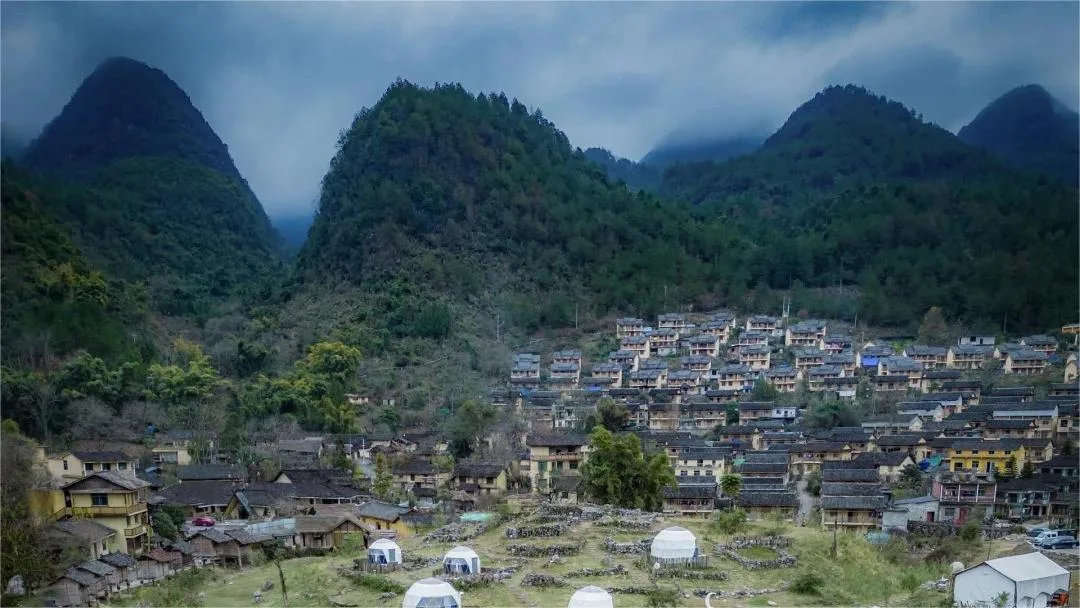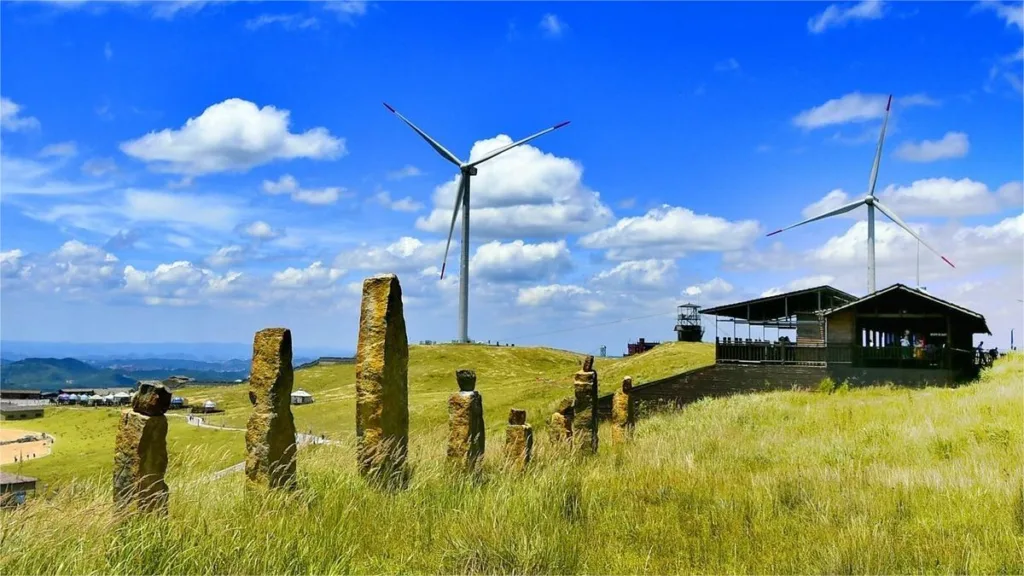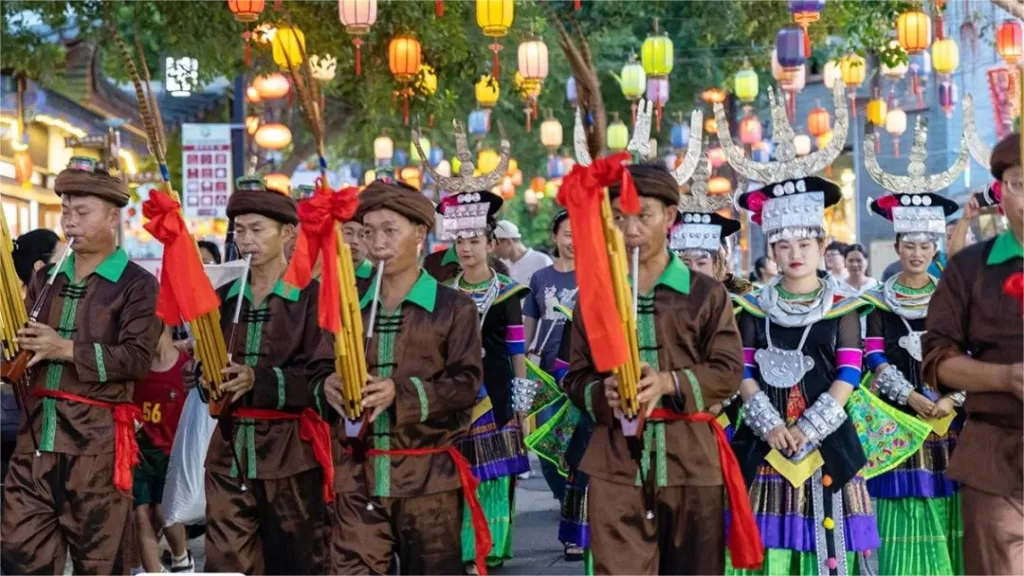Yaoshan Ancient Village (瑶山古寨), located in Libo County, Guizhou Province, is renowned as the last gun-bearing tribe in China. Some areas still retain the primitive farming methods of “slash-and-burn” and the rugged ethnic customs, earning it the title of “living fossil of primitive society.” The Bai Ku Yao, also known as the White Trouser Yao, are likened by anthropologists to the “Eastern Indians.”
The origins of the Yao people in Libo vary in interpretations. Some suggest they originated from the “Shan Yue” people, with their original habitat believed to be in present-day Jiangsu, Zhejiang, and around the Shibaodian in Nanjing. Others propose they descended from the “Wuling Man” of Changsha, inhabiting the Xiang, Zi, and Yuan River basins, as well as the Dongting Lake coastal areas. Additionally, there are suggestions of their ancestry from the “Wuxi Man,” with influences from the “Shan Yue” group. Regardless of their origins, Yaoshan Ancient Village stands as a testament to their rich cultural heritage, preserving ancient traditions amidst modernization.
Table of Contents
- Basic Information
- Location and Transportation
- Map of Yaoshan Ancient Village
- Highlights of Yaoshan Ancient Village
- Useful Tips Summarized from Reviews
- Other Attractions in Libo
Basic Information
| Estimated Length of Tour | 2 hours |
| Ticket Price | 100 RMB (admission + sightseeing bus) |
| Opening Hours | 8.30 – 19.30; Last admission: 18.30 |
| Telephone Number | 0086-0854-3561678 |
Location and Transportation
Yaoshan Ancient Village is situated in Lapian Village, Yao Township, Libo County, Qiannan Miao and Buyei Autonomous Prefecture, Guizhou Province. It is approximately 35 kilometers away from the county seat of Libo and just 5 kilometers from the renowned Xiaoqikong Scenic Area.
To get there, travelers can first take a long-distance bus from Guiyang or Duyun to Libo. From Libo, they can transfer to local buses or taxis to reach the village. Additionally, there is a tourist shuttle service from the East Gate Transit Center of Xiaoqikong, providing direct transportation to Yaoshan Ancient Village. Visitors who have finished exploring Xiaoqikong can also take this shuttle to reach the village conveniently.
Map of Yaoshan Ancient Village

Highlights of Yaoshan Ancient Village
Three Gates

Boundary Gate: This gate marks the territory of the Yao tribe, indicating that within this area, activities are under the jurisdiction of the tribe. Any activities undertaken within this territory must be reported to the Yao king of the village, failing which outsiders risk being expelled.
Defensive Gate: Historically, the Yao people were migratory, and in case of invasion or encroachment by other tribes or groups, elders would organize armed defense at this gate, wielding guns and bull horns to fend off attackers and protect their homeland. Today, it serves as a welcoming point for distinguished guests, with the sound of bull horns and gunfire signifying their arrival.
Guest Reception Gate: This gate serves as a focal point for important gatherings, such as ceremonies, festivals, and hunting expeditions. In ancient times, hunters would seek blessings from the Yao king and shamans before embarking on hunts, performing rituals at this gate to ensure a successful and bountiful hunt.
Brewery

The brewery holds significant importance in Yao culture as they believe “no feast is complete without alcohol.” Liquor plays a vital role in hospitality, as well as in religious rituals and ancestral worship, symbolizing peace and prosperity. Brewing liquor is considered one of the essential crafts for Yao women, who use unique techniques and herbal ingredients to produce flavorful and aromatic beverages.
Bronze Drum Plaza

The Yao people are among the ethnic groups that hold the bronze drum in high esteem, considering it a sacred object. Suspended on racks, the drums are struck from the sides, producing deep resonant tones accompanied by wind instruments. The Bronze Drum Plaza serves as a venue for welcoming guests with the majestic sound of the bronze drums, which are often used during ceremonies, important festivals, and celebratory occasions.
Bird Fighting Arena

Bird keeping serves as a recreational pastime in Yaoshan Ancient Village. Historically, the Yao people, particularly the affluent nobility, were skilled hunters. Bird keeping evolved into a leisure activity for the White Trouser Yao, even after the loss of wealth and status. Yao men often carry bird cages and gather at designated spots for bird fighting matches, creating lively scenes at the bird fighting arena.
Granary Cluster

The granaries stand as iconic historical structures within Yaoshan Ancient Village, with some dating back hundreds of years. Constructed with four pillars supporting wooden boards and surrounded by bamboo fences in a circular layout, the granaries are topped with thatched roofs. These structures served as storage facilities for grains and valuable items, providing protection against moisture, theft, and rodents. Beneath the granaries, tools for production or spaces for communal gatherings and conversations are often found.
Yao Pottery Kiln

The Yao people, known as “kiln people” in their early history, have a tradition of pottery making. Yao pottery, made from clay found in the Yao mountains, contains beneficial minerals like zinc and calcium and possesses acid and alkali resistance. The pottery, known for its fine texture and durability, is both functional and decorative. Yao pottery is not only used for storing daily necessities but also extensively employed in adorning granary structures.
Yao King’s Residence

The Yao King’s residence, known as the Yao King’s Court, is where the Yao king and elders convene for discussions and decision-making. This unique two-story courtyard-style building serves multiple purposes: the ground floor serves as a place for administering punishment to those who violate tribal rules, while the upper floor is reserved for important deliberations and announcements regarding significant matters within the tribe. The egalitarian nature of the Yao King’s Court, shaped like a hearth, symbolizes equality and unity among the Yao people.
Yao King’s Banquet

The “Yao King’s Banquet” symbolizes the solidarity and communal spirit of the Yao people. During significant events such as weddings, funerals, or welcoming new family members, every household in the village contributes a square table adorned with four dishes, four pounds of rice wine, four pairs of bowls and chopsticks, and four wine cups. The entire village gathers in the central square, where dozens to hundreds of tables are set up for the banquet. This grand feast brings together people of all ages to share in the celebration, enjoy the sumptuous meal, and partake in performances.
Market Days (Weishi)

Market days hold special significance for the White Trouser Yao, akin to festive occasions. Divided into day markets and night markets, these gatherings serve both material and social purposes. Day markets are bustling with trade, accompanied by the exchange of stories over wine until revelers return home in a merry haze. Night markets, on the other hand, are places of emotional connection and romance. As night falls, young men and women engage in playful pursuits, serenading each other with songs of love until the early hours of the morning, reluctant to part ways.
Batik Workshop

The batik workshop is where the White Trouser Yao carry out the intricate process of batik dyeing and spinning yarn for their traditional attire. Visitors to the workshop can witness the entire process of crafting Yao ethnic clothing, from designing and waxing patterns to dyeing and weaving. In 2006, Yao ethnic clothing was recognized as a national-level intangible cultural heritage, underscoring its significance in preserving the cultural identity of the Yao people.
Useful Tips Summarized from Reviews
Watch “Yao People” Performance: Highly recommended is the “Yao People” performance starting at 7:30 PM. It’s a captivating hour-long show that beautifully portrays the life of the Yao ethnic group. The performance includes showcasing their traditional attire, lively monkey drum dances, bamboo pole dances, and ends with a lively bonfire party. Both adults and children thoroughly enjoy the performance. Don’t miss the opportunity to take photos with the locals after the show. The cost for the performance is 50 yuan per adult.
Experience Yao King Banquet (Long Table Banquet): Another must-try experience is the Yao King Banquet, also known as the Long Table Banquet, starting at 7:00 PM. Seating is organized into tables of six, and it’s advisable to arrive early as the tables fill up quickly. The cuisine mainly consists of spicy dishes, so be prepared for a flavorful experience. The cost for adults is 50 yuan per person, while children are charged 30 yuan per person.
Explore the Service Center: The service center in the scenic area is quite spacious and well-equipped. There are large tables and chairs in the rest area, and even the VIP lounge is accessible for visitors to relax. The VIP area is furnished with comfortable seating and even has a bookshelf for those interested in reading. If you have belongings to store, you can easily arrange for storage with the staff at the front desk.








